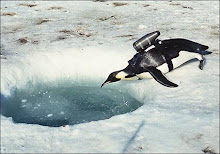A blogger has gone to the trouble of quantifying which banks are in trouble.
This list is unofficial. I also like how the author has composed a list of banks that have reserves that far exceed FDIC guidelines. The author 'tubeguy' calls them nice banks. Those could be called safe havens.
Nicebanks part 1
Nicebanks part 2
Largest watch banks are Westbank (Puerto Rico), AM trust of Georgia, and Chevy Chase. In other words, banks that are a fraction of the size of Indymac. (Whew!) I think some large banks will get into trouble, but if that's more than a year away... they will have the time to earn a bit of income decreasing their chance of trouble.
Black backgrounds are banks that the FDIC has already started to play their role.
The first seventy are colored red (if not black) due to 'an effective tier 1 leverage ratio less than 4%' (below FDIC guidelines, but not officially) In rough numbers, every bank colored red would need to fail to create the impact of Indymac's failure. This is good news. It implies that there is a less chance of a premature shock to the financial system. (Assuming stocks hold up, we do not have another Indymac that went from 'officially healthy' to receivership in two weeks, etc.)
Do note that there are about 6000 banks in the US (I think that number includes credit unions). So most banks are healthy and thus can be skipped in this discussion. I'll be following this list to see how it grows.


Every Friday one has to look to see what (if any) banks failed:
Today's failure,
Note: West coast failures could still happen. Its a 3 day weekend... a typical time for the FDIC to clear house. But lookie... 100% coverage of all deposits. So head to the new bank and just order checks (a 'no biggie') :)
http://www.geocities.com/tubeguy@rogers.com/troubledbanks.htm
Please also look at gasoline deliveries. We're in a bad recession if those numbers are not revised up:
http://tonto.eia.doe.gov/dnav/pet/hist/a103600001m.htm
Next day edit:
Economist article on American Banks
From the above: The trajectory is steep: Institutional Risk Analytics, which monitors the health of banks, expects more than 100 lenders—most, but by no means all, tiddlers—to fold over the next year alone. Alarmingly, the ratio of loan-loss provisions to duff credit is at its lowest level in 15 years.
.....
Ms Bair has indicated that banks with risky profiles—which already pay up to ten times more than the typical five cents per $100 insured—will be asked to “step up to the plate” with even higher premiums. This would ensure that safer banks are not unfairly burdened. But it will heap yet more financial pressure on strugglers. Bankers’ groups have already started to protest loudly.
How much will be needed? Possibly far more than the FDIC is letting on, reckons Joseph Mason of Louisiana State University. Extrapolating from the savings and loan crisis of the early 1990s, and allowing for the growth in bank assets, he puts the possible cost at $143 billion.
Got Popcorn?
Neil

1 comment:
Note:
I've found two banks with large troubled loan pools that are not on the spreadsheet: Wamu and Downey Savings. So if anything, this is a starter list. Recall, Indymac went from being 'well capitalized' to failed in two weeks! Too many banks are holding off realizing losses that should have been booked several quarters ago. While half the banks are certainly healthy... there is a large gray zone.
Got Popcorn?
Neil
Post a Comment